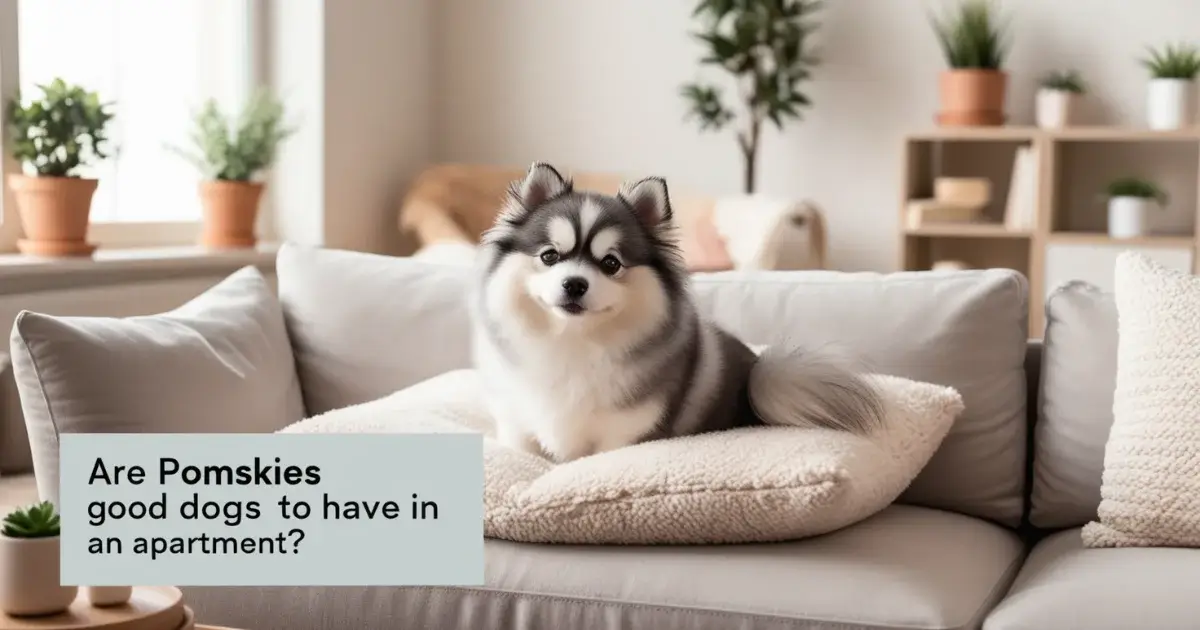Are Pomskies Good Dogs to Have in an Apartment?

Pomskies, a mix between Pomeranians and Huskies, have captured the hearts of dog lovers with their adorable appearance and lively personalities. But the big question remains: Are Pomskies good dogs to have in an apartment?
The answer is yes, but only if their specific needs are met. These dogs are adaptable and affectionate, making them wonderful companions in small spaces. However, they require regular exercise, training, and attention to thrive. In this guide, we’ll explore what makes Pomskies in apartments a good fit, the challenges they bring, and the steps you can take to ensure they live a happy life.
Table of Contents
What Makes Pomskies Suitable for Apartment Living?
Size and Adaptability
One of the main reasons Pomskies in apartments work well is their size. They are generally small to medium-sized dogs, making them a manageable option for smaller living spaces. Their compact build allows them to fit comfortably in tight quarters without feeling confined.
In my experience, “Pomskies can thrive in apartments if their energy is directed properly. Their adaptable temperament makes them an ideal choice for city dwellers.” When given the right care, they can easily adjust to the apartment lifestyle.

Affectionate Nature
Pomskies are known for their affectionate personalities. They love forming strong bonds with their owners, which is a big plus for people who live in apartments and spend a lot of time at home. Their playful and loving nature creates a warm and vibrant atmosphere.
“A Pomsky’s affectionate personality turns any small apartment into a lively and joyful home,” is something I’ve observed. They thrive on interaction and attention, which helps them feel secure and happy in smaller spaces.
Challenges of Keeping a Pomsky in an Apartment
While Pomskies can do well in apartments, there are certain challenges you need to consider.
High Energy Levels
Pomskies are energetic dogs. They need regular exercise to stay happy and healthy. Without proper outlets for their energy, they can become bored, which often leads to destructive behaviors like chewing or digging.
Pomsky exercise needs include daily walks and active play sessions. From my experience, “If you don’t keep a Pomsky active, they’ll find their own ways to entertain themselves, and that’s rarely good news.”
Barking Concerns
A common trait among Pomskies is their vocal nature. They inherit this from both the Pomeranian and Husky breeds, making them naturally inclined to bark or “talk.” In an apartment setting, this can cause issues with neighbors if not managed effectively.
To address this, early training is essential. Teaching them when it’s appropriate to bark can prevent disturbances. “Training a Pomsky to control their barking is a must for peaceful apartment living,” I’ve found.
Limited Space and Socialization
Another challenge of apartment dog breeds like Pomskies is providing enough socialization. Living in a small space can limit their interactions with other dogs and people, which are crucial for their development.
Regular trips to dog parks or scheduling playdates are great ways to ensure they get the social exposure they need. “Socializing a Pomsky is key to helping them become confident and well-adjusted pets,” in my opinion.
Tips for Thriving with a Pomsky in an Apartment
Living with a Pomsky in an apartment requires planning and dedication. Here are some tips to help them thrive:
Meeting Exercise Needs
Exercise is vital for Pomskies. They need both physical and mental stimulation to channel their energy positively.
- Take them on daily walks, at least twice a day.
- Engage in active play, like fetch or tug-of-war.
- Use interactive toys or puzzle games to challenge their intelligence.
“A well-exercised Pomsky is a happy Pomsky,” and this is especially true in apartments. These activities will help keep their mind sharp and their behavior in check.
Training Essentials
Training is crucial for managing behaviors like barking and ensuring good manners in small spaces. Start with basic commands and focus on positive reinforcement.
- Teach commands like “quiet” to manage barking.
- Be consistent with rules to avoid confusion.
- Use rewards like treats or praise to encourage good behavior.
“Consistency and patience in training can transform a Pomsky into a well-behaved apartment companion,” I’ve seen this firsthand.
Social Interaction
Socializing your Pomsky is as important as exercise and training. Regular interaction with other dogs and people helps them stay well-adjusted.
- Visit dog parks for off-leash playtime.
- Schedule playdates with other dog owners.
- Introduce them to new environments to build their confidence.
“A well-socialized Pomsky is a joy to have around, and their cheerful energy lights up any home,” in my experience.

Is a Pomsky the Right Fit for Your Apartment Lifestyle?
Before deciding, weigh the pros and cons of having a Pomsky in an apartment. Their size and affectionate nature make them ideal companions, but their energy levels and vocal tendencies require effort and commitment.
If you’re ready to invest time in exercise, training, and socialization, Pomskies can be excellent apartment pets. For tailored advice, consult a breeder or veterinarian who knows the breed well.
Pros and Cons of Pomskies in Apartments
| Pros | Cons |
| Small to medium size | High energy levels |
| Adaptable temperament | Vocal tendencies (barking) |
| Affectionate and loving | Requires regular socialization |
| Great companions | Needs consistent training |
Conclusion
So, are Pomskies good dogs to have in an apartment? Absolutely, but they come with responsibilities. With their adaptable size, loving nature, and lively energy, they make fantastic companions. However, you’ll need to commit to meeting their exercise, training, and social needs to ensure they thrive.
Pomskies can turn any small living space into a warm and joyful home. If you’re prepared to give them the care they need, they’ll reward you with endless love and loyalty. Make an informed decision and get ready to welcome a new best friend into your life!
FAQs
Are Pomskies in apartments prone to destructive behavior?
Without enough activity and stimulation, Pomskies may become bored and chew furniture or other items. Regularly meeting Pomsky exercise needs and providing interactive toys can help prevent destructive behavior.
How do you manage Pomsky barking in shared spaces?
To address managing Pomsky barking, start with early training using commands like "quiet" and reward positive behavior. Consistency is key to reducing excessive barking and ensuring peaceful apartment living.
Are Pomskies considered good apartment dog breeds for families?
Yes, Pomskies are affectionate and adaptable, making them great apartment dog breeds for families. However, their energy and need for social interaction mean they thrive best in households with active and attentive members.
Can Pomskies in apartments get enough socialization?
Yes, by visiting dog parks, arranging playdates, or taking them to pet-friendly spaces. Regular outings ensure Pomskies in apartments interact with other dogs and people, helping them develop confidence and reduce anxiety.






